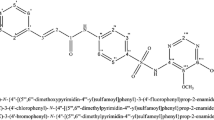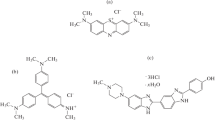Abstract
The mechanism of interaction of a non-glycosidic citrus flavonoid, hesperitin (HES) with bovine serum albumin (BSA) was studied by UV–vis absorption, fluorescence, FT-IR, circular dichroism, fluorescence anisotropy and synchronous fluorescence spectroscopy in phosphate buffer of pH 7.4. Fluorescence data revealed that the fluorescence quenching of BSA by HES was the result of the formed complex of HES–BSA. The binding constants and thermodynamic parameters at four different temperatures, the location of binding, and the nature of binding force were determined. The hydrogen bonds interactions were found to be the predominant intermolecular forces to stabilize the complex. The conformation of BSA was discussed by synchronous fluorescence and CD methods. The alterations of protein secondary structure upon complexation with HES were evident from the gradual decrease in α-helicity. The distance between the donor (BSA) and acceptor (flavonoid) was calculated from the fluorescence resonance energy transfer and found to be 1.978 nm. Common ions viz., Zn2+, K+, Cu2+, Ni2+, Mn2+ and Co2+ were found to influence the binding of flavonoid to protein.









Similar content being viewed by others
References
Finkel T, Holbrook NJ (2000) Oxidants, oxidative stress and the biology of ageing. Nature 408:239–247
Peters T (1996) All about albumin, biochemistry, genetics and medical application. Academic Press, San Diego
Heim KE, Tagliaferro AR, Bobilya DJ (2002) Flavonoid antioxidants: chemistry, metabolism and structure-activity relationships. J Nutr Biochem 13:572–584
Lefevre T, Subirade M (2001) Conformation rearrangement of β-lactoglobulin upon interaction with an anionic membrane. Biochim Biophys Acta 1594:37–50
Xie MX, Jiang M, Li S, Liu Y (2004) Studies on the interaction of β-1,2,3,4,6-penta-O-galloyl-d-glucopyranose with human serum albumin. Acta Chim Sin 62:1460–1466
Wen M-G, Zhang X-B, Tian J-N, Ni S-H, Bian H-D, Huang Y-L, Liang H (2009) Binding interaction of xanthoxylin with bovine serum albumin. J Solut Chem 38:391–401
Sun Y, Zhang H, Sun Y, Zhang Y, Liu H, Cheng J, Bi S, Zhang H (2010) Study of interaction between protein and main active components in Citrus aurantium L. by optical spectroscopy. J Lumin 130:270–279
Wang Y-Q, Zhang H-M, Zhang G-C, Tao W-H, Tang S-H (2007) Interaction of the flavonoid hesperidin with bovine serum albumin: a fluorescence quenching study. J Lumin 126:211–218
Xie M-X, Xu X-Y, Wang Y-D (2005) Interaction between hesperetin and human serum albumin revealed by spectroscopic methods. Biochim Biophys Acta 1724:215–224
Jinyao Z, Fenglian R (2009) Influence of hydroxylation and glycosylation in ring A of soybean isoflavones on interaction with BSA. Spectrochim Acta A 72:682–685
Lakowicz JR (1999) Fluorescence quenching: theory and applications. Principles of fluorescence spectroscopy. Kluwer Academic, New York
Liu YM, Li GZ, Sun XF (2004) Study on the interaction between colchicine and bovine serum albumins by fluorescence method. Chin J Anal Chem 32:615–618
Feng XZ, Lin Z, Yang LJ, Wang C, Bai CL (1998) Investigation of the interaction between acridine orange and bovine serum albumin. Talanta 47:1223–1229
Khan SN, Islam B, Rajeswari MR, Usmani H, Khan AU (2008) Interaction of anesthetic supplement thiopental with human serum albumin. Acta Biochim Polon 55:399–409
Ross PD, Subramanian S (1981) Thermodynamics of protein association reactions: forces contributing to stability. Biochemistry 20:3096–3102
Yue Y, Zhang Y, Zhou L, Qin J, Chen X (2008) In vitro study on the binding of herbicide glyphosate to human serum albumin by optical spectroscopy and molecular modelling. J Photochem Photobiol B 90:26–32
Sudlow G, Birkett DJ, Wade DN (1975) The characterization of two specific drug binding sites on human serum albumin. Mol Pharmacol 11:824–832
Gerbanowski A, Malabat C, Rabiller C, Gueguen J (1999) Grafting of aliphatic and aromatic probes on rapeseed 2S and 12S proteins: influence on their structural and physicochemical properties. J Agric Food Chem 47:5218–5226
Sengupta A, Hage DS (1999) Characterization of minor site probes for human serum albumin by high-performance affinity chromatography. Anal Chem 71:3821–3827
Yamasaki K, Maruyama T, Kragh-Hansen U, Otagiri M (1996) Characterization of site I on human serum albumin: concept about the structure of a drug binding site. Biochim Biophys Acta 1295:147–157
Förster T, Sinanoglu O (1996) Modern quantum chemistry, vol 3. Academic Press, New York
Jurasekova Z, Marconi G, Sanchez-Cortes S, Torreggiani A (2009) Spectroscopic and molecular modeling studies on the binding of the flavonoid luteolin and human serum albumin. Biopolymers 91:917–927
Predki PF, Harford C, Brar P, Sarkar B (1992) Further characterization of the N-terminal copper(I1)-and nickel(I1)-binding motif of protein. Biochem J 287:211–215
Cui F, Zhang Q, Yan Y, Yao X, Qu G, Lu Y (2008) Study of characterization and application on the binding between 5-iodouridine with HSA by spectroscopic and modeling. Carbohydr Polym 73:464–472
Zhou J, Wu X, Gu X, Zhou L, Song K, Wei S, Feng Y, Shen J (2009) Spectroscopic studies on the interaction of hypocrellin A and haemoglobin. Spectrochim Acta Part A 72:151–155
Klajnert B, Bryszewska M (2002) Fluorescence studies on PAMAM dendrimers interactions with bovine serum albumin. Bioelectrochemistry 55:33–35
Stan D, Matei I, Mihailescu C, Savin M, Matache M, Hillebrand M, Baciu I (2009) Spectroscopic investigations of the binding interaction of a new indanedione derivative with human and bovine serum albumins. Molecules 14:1614–1626
Bentley KL, Thompson LK, Klebe RJ, Horowitz PM (1985) Fluorescence polarization: a general method for measuring ligand binding and membrane microviscosity. BioTechniques 3:356–365
Lu ZX, Cui T, Shi QL (1987) Applications of circular dichroism and optical rotatory dispersion in molecular biology, 1st edn. Science Press, Beijing
Mandal P, Ganguly T (2009) Fluorescence spectroscopic characterization of the interaction of human adult hemoglobin and two isatins, 1-methylisatin and 1-phenylisatin: a comparative study. J Phys Chem B 113:14904–14913
Li Y, He WY, Dong Y, Sheng F, Hu Z (2006) Human serum albumin interaction with formononetin studied using fluorescence anisotropy, FT-IR spectroscopy and molecular modeling methods. Bioorg Med Chem 14:1431
Acknowledgments
We are grateful to the Council of Scientific and Industrial Research, New Delhi, for financial assistance (No. 01(2279)/08/EMR-II dated 20-11-2008). One of the authors (AHH) thanks the UGC, New Delhi for awarding the Fellowship for meritorious students in Science. Thanks are also due to the authorities of the Karnatak University, Dharwad, for providing the necessary facilities.
Author information
Authors and Affiliations
Corresponding author
Rights and permissions
About this article
Cite this article
Hegde, A.H., Sandhya, B. & Seetharamappa, J. Evaluation of binding and thermodynamic characteristics of interactions between a citrus flavonoid hesperitin with protein and effects of metal ions on binding. Mol Biol Rep 38, 4921–4929 (2011). https://doi.org/10.1007/s11033-010-0634-9
Received:
Accepted:
Published:
Issue Date:
DOI: https://doi.org/10.1007/s11033-010-0634-9




